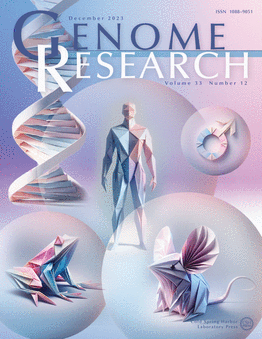人乳头瘤病毒整合事件中病毒和人类基因组的重排及其等位基因特异性对癌症基因组调控的影响
IF 6.2
2区 生物学
Q1 BIOCHEMISTRY & MOLECULAR BIOLOGY
引用次数: 0
摘要
人乳头瘤病毒(HPV)的整合与HPV感染转化为癌症有关。为了解决与HPV整合相关的基因组失调,我们对来自乌干达数据集的72个宫颈癌基因组进行了牛津纳米孔长读测序,该数据集以前使用短读测序进行了表征。我们在HPV整合事件中发现了反复出现的结构重排模式,我们将其分类为:del(突变)样、dup(粘合)样、易位、多点断点或重复区域整合。涉及扩增的人乳头瘤病毒-人串联体的整合,特别是多点断点事件,经常包含病毒基因组的异质形式和拷贝数。转录活性整合子的特征是在病毒转录起始位点下游的病毒和人类基因组中存在未甲基化的区域,导致hpv -人融合转录物。相比之下,没有表达证据的整合子缺乏一致的甲基化模式。此外,尽管转录失调仅限于HPV整合物200千碱基内的基因,但无论整合物的转录状态如何,人类表观基因组以等位基因差异甲基化区域形式的失调都会影响基因组的大碱基扩展。通过阐明HPV整合的结构、表观遗传和等位基因特异性影响,我们深入了解了整合HPV在宫颈癌中的作用。本文章由计算机程序翻译,如有差异,请以英文原文为准。
Rearrangements of viral and human genomes at human papillomavirus integration events and their allele-specific impacts on cancer genome regulation
Human papillomavirus (HPV) integration has been implicated in transforming HPV infection into cancer. To resolve genome dysregulation associated with HPV integration, we performed Oxford Nanopore long-read sequencing on 72 cervical cancer genomes from an Ugandan dataset that was previously characterized using short-read sequencing. We found recurrent structural rearrangement patterns at HPV integration events, which we categorized as: del(etion)-like, dup(lication)-like, translocation, multibreakpoint, or repeat region integrations. Integrations involving amplified HPV-human concatemers, particularly multibreakpoint events, frequently harbored heterogeneous forms and copy numbers of the viral genome. Transcriptionally active integrants were characterized by unmethylated regions in both the viral and human genomes downstream from the viral transcription start site, resulting in HPV-human fusion transcripts. In contrast, integrants without evidence of expression lacked consistent methylation patterns. Furthermore, whereas transcriptional dysregulation was limited to genes within 200 kilobases of an HPV integrant, dysregulation of the human epigenome in the form of allelic differentially methylated regions affected megabase expanses of the genome, irrespective of the integrant's transcriptional status. By elucidating the structural, epigenetic, and allele-specific impacts of HPV integration, we provide insight into the role of integrated HPV in cervical cancer.
求助全文
通过发布文献求助,成功后即可免费获取论文全文。
去求助
来源期刊

Genome research
生物-生化与分子生物学
CiteScore
12.40
自引率
1.40%
发文量
140
审稿时长
6 months
期刊介绍:
Launched in 1995, Genome Research is an international, continuously published, peer-reviewed journal that focuses on research that provides novel insights into the genome biology of all organisms, including advances in genomic medicine.
Among the topics considered by the journal are genome structure and function, comparative genomics, molecular evolution, genome-scale quantitative and population genetics, proteomics, epigenomics, and systems biology. The journal also features exciting gene discoveries and reports of cutting-edge computational biology and high-throughput methodologies.
New data in these areas are published as research papers, or methods and resource reports that provide novel information on technologies or tools that will be of interest to a broad readership. Complete data sets are presented electronically on the journal''s web site where appropriate. The journal also provides Reviews, Perspectives, and Insight/Outlook articles, which present commentary on the latest advances published both here and elsewhere, placing such progress in its broader biological context.
 求助内容:
求助内容: 应助结果提醒方式:
应助结果提醒方式:


